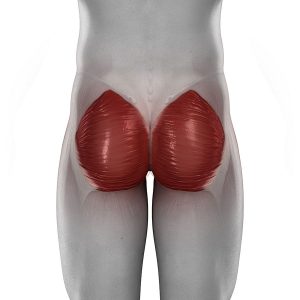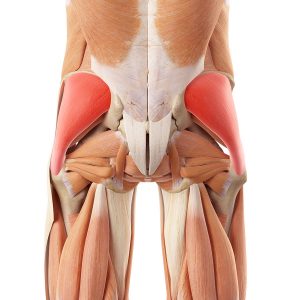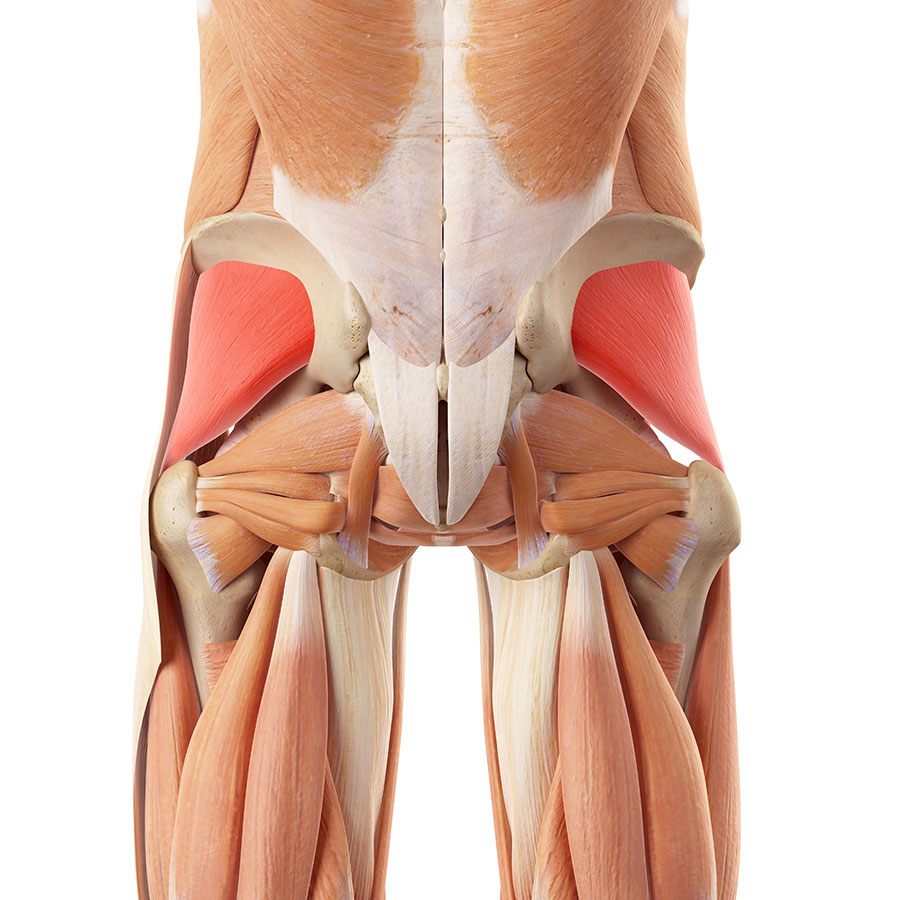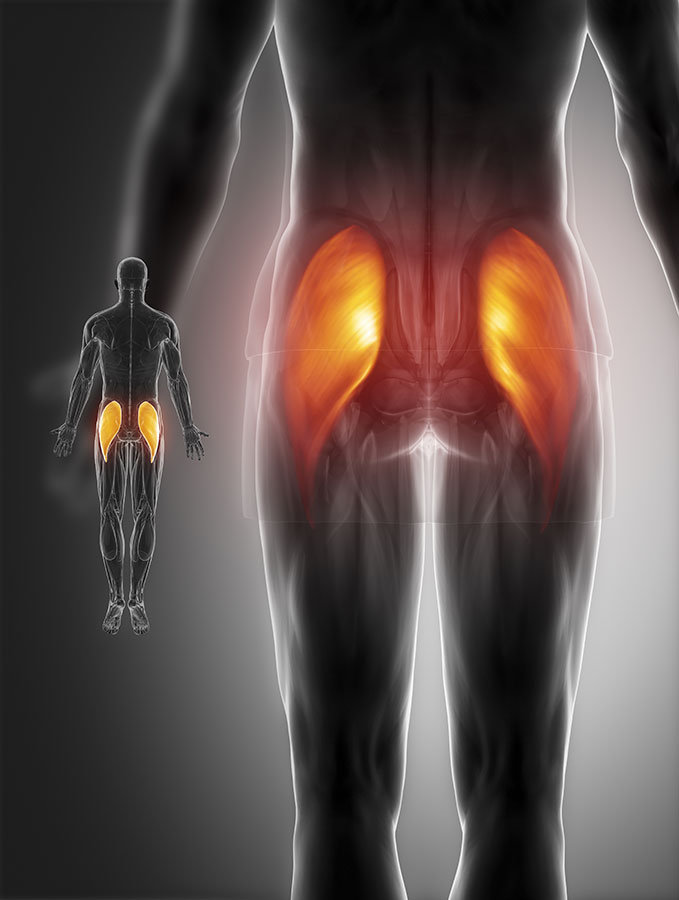Gluteus muscles strain is a literal pain in the butt. Any of the three muscles, gluteus maximus, gluteus medius or gluteus minimus, can give you a sore buttocks. Getting up from sitting, weight bearing while walking or climbing stairs will cause sharp pain in your buttocks or hip. A deep, dull ache that radiates to your hip can also be caused by a gluteus muscle strain. Give us a call to identify the origin of your buttock pain.
Each of the gluteus muscles plays a part in stabilizing the pelvis and allow controlled movement of the hip. Any one of these muscle fibers can be torn if the load placed on the muscle exceeds its normal boundaries. This will cause a gluteus muscle strain and lead to a sore buttock.
“Jumpers” are more likely to tear one of their gluteal muscles, due to the high intensity of the muscle contraction that is needed to push off out of a stretched position, for example sprinters, hurdlers, long jumpers and especially triple jumpers.
What are the glutes?
The “glutes”, as they are affectionately referred to by admirers all over the world are a group of three muscles that run from the pelvic rim (illiac crest) and sacrum diagonally downward towards the femur (thigh bone). They are layered, the deepest and smallest gluteus minimus muscle, runs vertically down on the outside of the hip, with gluteus medius in-between, and the biggest, gluteus maximus, most superficial.
Lets examine each muscle separately and look at what movements they are responsible for, to understand where your buttock pain is coming from:
What does the gluteus muscles do?
Gluteus Maximus muscle
As the name implies it is the largest of the group. It is regarded as the strongest muscles in the human body and is responsible for hip extension (leg moves backwards). The gluteus maximus has an important role in walking (or running) as it propels the body forward during the push off phase in the gait cycle.
It allows you to straighten your hips when standing up out of a chair or when walking up stairs. Gluteus Maximus pain will influence your ability to get out of a chair and climb stairs with ease.


Gluteus Medius muscle
The in between muscle is responsible for abduction (moving the leg sideways). It plays a vital role in keeping your hips level when walking or running, as in the opposite of a runway model’s hips that sway from side to side. The adductor muscle group, on the inside of the thigh, works synergistically to keep your pelvis stable when you are transferring your weight from one leg to the other.
Its connection with the iliotibial band steadies the femur (thigh bone) on the articular surfaces of the tibia during standing, walking and jumping. This influences the force transferred to the leg, knee and ankle. Any inhibition, weakness or tear can influence the biomechanics of the entire lower limb and lead to ITB syndrome, shin splints, ankle injury or Achilles tendonitis on top of the gluteus medius pain.
Gluteus Minimus muscle
The gluteus minimus is a secondary muscles, that assist with extending the hip. It is located deep and somewhat in front of the gluteus medius muscle. The gluteus minimus helps to move your leg sideways away from your midline (abduct) and turns the thigh inwards (internal rotation). It aids the gluteus medius to stabilise the hip and pelvis when the opposite leg is raised from the ground.

How does a Gluteus muscle strain happen?
When your buttock muscle needs to contract at a high force, while it is in a stretched position, it leads to overload and small microscopic tears in the gluteal muscle fibers. A small bundle of fibers can tear, or large deep tears can split fibers along the length of the gluteal muscles. Your nervous system will react by contracting the muscle and increasing the muscle tension to protect itself. This results in a temporary shortening of the muscle to allow healing to take place.
When you go into a position where you stretch or contract your gluteal muscles, you will feel a sharp stinging feeling. This is because the more you stretch it, the more you damage the scar, which is trying to heal the muscle fibers. It is like picking at a scab and not allowing it to heal.
Movements like bending forward to pick up something from the floor, or sitting down from standing, will stretch the gluteal muscles and cause buttock pain. Pain when contracting the gluteus muscles involves standing up out of a chair, therefore the deeper the seat, the more the pain. Even walking up stairs puts the guleus muscles under full tension while at stretch & under full load.
Gluteal strains usually occur due to a sudden contraction of the gluteal muscles, often when they are in a stretched position. This sometimes occurs with rapid acceleration while running, especially up-hills, or when performing an explosive jump, or when lifting excessive weight e.g. loaded squats or lunges in the gym. This can lead to Gluteus Maximus or Gluteus Medius pain.
3 ways the gluteal muscles tear
- Sudden deceleration of the hip and leg (e.g. landing from a jump)
- Violent contraction of the gluteul muscles (jumping, lunges, stair sprints)
- Rapid deceleration of an overstretched muscle (by quickly change of direction) Jump from a lunge position, plyometric jumps.
Causes of Gluteus Muscle Strain
Acute Injury
This is when you feel sudden buttock pain after a training session or fall.
- Overuse – Increasing your running distance too fast or a sudden increase in repetitive jumps.
- Overload – Increasing the weight of the leg press machine too fast.
- Overstretch – Running uphill sprints will force the muscles to contract from its stretched position. Muscles are vulnerable in a stretched position.
Chronic wear & tear
- Weakness – Muscle fatigue can play a role in jumpers and runners who are not conditioned to handle the distance. When you run a long distance and your muscles can’t keep up, they will fatigue leading to a irregular rocking motion in your hips. This puts more strain on the muscles and can lead to gluteus Maximus pain.
- Poor technique – During training a wrong movement pattern, can load your gluteus significantly more when doing squat, lunges or jumps. The forces around your hip muscles may converge onto a specific line of fibers, focusing the tension on certain fibers and cause gluteus medius pain.
- Inadequate warm-up – A fast sudden contraction, like a jump or sprinting when the muscle is not prepared for it can put you at risk of tearing the gluteus muscles.
- Excessive stretching – of the muscle against a force, for example during weight lifting, like a deadlift. When the load is applied on both sides of the tendon, while it needs to contract & lengthen at the same time. The same goes for jumping lunges, squats and plyometric training.
- Wrong shoes – Poor support for your feet will cause muscle forces to concentrate along the outside of your leg, which load those muscle fibers more that the inner part. This abnormal force on the outside of your leg will cause the fibers to fatigue faster and tear first.
How bad is my Gluteus muscle strain?

Grade 1
A grade 1 gluteus muscle strain refers to between 5 – 10% of muscle fibers torn as a result of over stretch or overload. This can be true for one of the 3 layers of the gluteal muscles, or all 3 layers.
Grade 2
A grade 2 muscle strain refers to between 10 – 80% of muscle fibers torn as a result of over stretch or overload. This can be true for one of the 3 layers of the gluteal muscles, or all 3 layers. This is a very “wide range” of what could possibly be going on inside the muscle belly. For a more accurate diagnosis a sonar can be helpful.
Grade 3
A grade 3 gluteus muscle strain refers to between 80 – 100% of muscle fibers torn as a result of over stretch or overload. 100% tear or a full rupture means that the muscle is actually torn in two part. As the parts are not connected anymore, they do not have leverage over the joints and cannot produce movement. Because the nerve fibers tear together with the muscle fibers this may be surprisingly not as painful as the loss of function.
Diagnosis of gluteus muscle strain
Our physiotherapists know and understand the intricacy of the anatomy of your hip & buttock. There are many structures to test, we’ll be stretching & stressing the soft tissue structures like muscles, ligaments, nerves and tendons. We’ll test different aspects like muscle strength, lengths, range of motion, flexibility and stability, in order to confirm how severe your tissue damage is. Our physiotherapists are experts that dissect the complex biomechanics of your hip through our evaluation, which allows us to make an accurate diagnosis. We’ll tell you whether gluteus Maximus, Medius or Minimus muscle is injured and to what extent.
Although the gluteus muscles work as a group, each has a specialized task that it is responsible for. Gluteus Maximus extends the hip and to a lesser degree the lower back, while Gluteus Medius moves the thigh outwards. This is especially important to keep the hips level and stable when you have only one leg on the ground, like when you are running. We will test the muscles while bearing weight and without to determine which gluteus muscle is injured and causing your pain.
We gather information based on your individual injury, then we’ll customize the treatment to your specific needs. Therefore our physiotherapists are the best at diagnosing gluteus muscle strains & buttock pain.
X rays
X-rays show bones and will therefor not helpful to diagnose a gluteal muscle strain (which is soft tissue). It is helpful to rule out fractures if your injury was caused by a traumatic incident, like a fall or car accident.
Sonar
Diagnostic ultrasound show soft tissue, the muscle bellies and tendinous attachment, and is the image of choice to diagnose gluteal muscle strain. The exact location, orientation, length and depth of the tear can be visualized with a sonar.
MRI
A MRI is a costly imaging procedure that can only be ordered by a specialist. An uncomplicated gluteal strain does not need a MRI for diagnosis. So, an MRI wouldn’t be necessary if you have a sore buttocks.
Why is my buttock pain not going away?
Your injury may have been caused by a grade 1 muscle strain months ago when you suddenly had to run after the dog. This was just a small “niggle” initially and so you rested a few days and went back to your exercise regime. When you train or continue with your normal activities, despite the sore buttock, your body will find a way to make you listen. As a result of the injury the muscle contracts to protect itself. From this contracted state it cannot function well, just like you can’t play tennis while carrying a bag full of groceries. The muscle can’t lengthen and contract to produce the same force it would have before the injury. Eventually a small tear develops into a bigger tear, until its too painful to contract or stretch your gluteal muscles.
The gluteal muscle group tends to tear over the center (belly) of the muscle. It is usually accompanied by tendinitis, this is an inflammation of the tendon junction where the muscle meats the bone. If the muscle pain doesn’t stop you, the nerve pain will. This is when the dull ache changes into a sharp stabbing buttock pain.
A big problem we see with gluteus muscle strains
The gluteus muscle group is subjected to a lot of load during a normal day, walking, climbing stairs, getting in and out of the car, so it can impact your life a great deal. So much more if you run or cycle. The gluteus muscles are responsible to keep the pelvis level during single leg weight bearing. So, if there’s a problem you can potentially experience Gluteus Maximus pain it with each step you take. It is difficult to rest for this reason, active rest with crutches for a short period of time can give you amazing results.
Poorly designed rehabilitation protocols, with an emphasis on single plane movement or low load exercise only, can be done diligently, but not yield the results that you were looking for. You rely on your hip to move in three dimensions, front to back, side to side, in a circle or a combination of all these movements. Like kicking a ball on the run, the muscles work in all the different directions. Giving up is not the answer. Consider a full rounded treatment option to beat your Gluteus Medius pain.
Medication or injections will definitely give you symptomatic relief, where the triggering movement is done with ease or no pain at all. It is like mopping up water and not fixing the burst pipe. Ideally you should address the root cause during this time of pain free movement. Or you risk your pain returning once the medication has worn off, with some nasty side effects maybe (constipation, peptic ulcers, etc.).
Physiotherapy treatment for gluteus muscle strain
Once we have established the cause of your gluteus muscle strain we can start the correct techniques to rehabilitate your specific injury. We make use of hands on techniques like myofascial release, massage, deep dry needling, joint mobilization and nerve glides, or electrotherapy, LASER, EMS, TENS or ultrasound and exercise prescription and/or immobilizatio to guide you through each phase of rehabilitation.
PRICE protocol
1st Phase: Protection & initial Healing
P
Protect.
We have found that patients tend to continue walking on the injured leg with a limp. The joint still has to carry the load every time that your weight is put onto the leg. It’s better to get crutches and wear a brace to keep the load off your knee and to stabilize your knee joint. The main concern is to prevent your injured knee ligament from tearing even further.
R
Rest.
Rest from activities that is worsening your pain.
Reduce the weight taken on the injured leg. Use crutches to take the load off your knee joint.
As soon as there’s no pain, don’t test it. Give it time to heal.
I
Ice.
Ice cubes wrapped in a towel, tied around your knee reduces pain & inflammation and speeds up the healing process. For at least the first 3 days or until the swelling goes down, apply an ice pack for 20 minutes every two hours. Always keep a towel between the ice and your skin (to prevent freeze burn).
C
Compress.
Use strapping or elastic compression bandage to keep your knee joint supported and prevent blood pooling around your knee and calf. This can be done either with taping or tube grip bandage and this helps to control swelling.
E
Elevate.
Lying on your back with your foot on a chair (your calf must be higher than your heart to allow gravity to assist in draining the pooled blood in your leg.) Raise your calf for 15 minute intervals during the day.
2nd Phase: Establish pain free range of movement
During your examination, it’ll become clear what you’ll be able to do, and what you should avoid. We identify factors that contribute to your pain, specific to your case. There is a pain free range of movement that you’re safe to move in, and our exercises will be targeted between these boundaries i.e pain free range is from 0 – 30 degrees, 30+ degrees is painful. On completion of this phase you should be able to perform movements within these limits.
As your rehabilitation progress we aim to gain a larger pain free range of movement while your painful range becomes less intense.
The scar tissue that forms the bridge between the uninjured fibers, must be able to lengthen and contract without any restrictions. We use massage, electrotherapy, stretches and neurodynamic mobilizations to achieve this. If the scar tissue is able to withstand the load you place through it, it prevents future reoccurrence.
3nd Phase: Tissue healing
We monitor the progress of you pathology and track the fibrous tissue formation, re-attachment and scar tissue healing of your injury. On a cellular level we’re able to accelerate tissue healing using dry needling, Laser, Ultrasound and electrotherapy.
4nd Phase: Tissue Stress & ability to heal
During each session we will re-evaluate if you are achieving the necessary targets for the tissue to be able to handle tensile, elastic and compression forces. We use isometric muscle contractions. These are muscle contractions without movement to keep the surrounding muscles active without compromising your injury site.
5nd Phase: Muscle Strength & Full Range of Movement
The most important component of rehabilitation is to regain full range of movement of the muscle fibers. The scar tissue that form inside the site of the tear must be lengthened and orientated to allow the muscle to contract without any restrictions. We use massage, stretches and neurodynamic mobilizations to achieve full range of movement.
On completion of this phase you should be able to walk comfortably and climb a flight of stairs with no pain.
6rd Phase: Eccentric Muscle Strength
Its common to feel some pain when we start contracting the muscle – this is due to breaking down abnormal fibrous tissue adhesion. A muscle contraction works in two directions: One where the muscle is contracted and it shortens, and the second where the muscle lengthens during contraction.Both these type of exercises is vital at conditioning the muscle fibers to absorb a force.
On completion of this phase you should be able to lower slowly down into a deep side squat with minimal pain.
7th Phase: Concentric Muscle Strength
Shortening of the muscle during a contraction involves strength and power exercises that will be progressed gradually as healing takes place. This will be tested frequently to determine if you can progress from non-weight bearing to full weight bearing (walking without crutches). Our physiotherapist will guide and monitor your gluteus muscles’ reaction to normal forces like walking, climbing stairs and driving.
On completion of this phase you should be able to contract your gluteus muscles against resistance, like side squats with resistance bands.
8th Phase: Testing for return to activity
Gradual build up into your previous intensity of normal activities and training to determine if your injury is able to withstand the repetitive loading without flare-ups. Our physiotherapist guides you to reengage in safe increments, and adjust where necessary. We’ll follow your progress and adapt where needed.
9th Phase: High Speed, Power, Proprioception
The gluteus muscles must be tested under high load and speed to ensure that the muscle will be able to keep up with the demand of your body. During this phase our physiotherapist will guide you to return to normal activities, this includes challenging your muscle past its ‘normal’ boundaries to determine how it reacts to different forces. Ultimately we prepare you to return to participating in your sport.
Whatever must be done – we’ll get you there. Jumps, Landing, Sprints, and much more.
10th Phase: Sport Specific Training
This is the final stage of rehabilitation that can last anything from 2-4 weeks. Our Physio will still use myofascial release, trigger point release and electrotherapy modalities where needed, but functional rehabilitation is most important during this phase.
Depending on your sport, our physiotherapist will tailor specific exercises that will help strengthen the muscles pertaining to your sport. A successful outcome is when you have gained knowledge throughout the rehabilitation program and can participate at full power and speed, not to mention the benefits of minimizing your chance of future injury.
Healing time of gluteus muscle strain
Muscles are capable of excellent tissue regeneration, which is good news for your sore buttocks. Healing takes place in three phases.
The degeneration-inflammation phase (first few days post injury) where inflammation caused by the injury, release cells to clean the debris and growth factor to stimulate phase 2 (that is why stopping inflammation within the first 48 hours is not a god idea). The reparative phase (day 7 – 21) spring cleans the area and stimulates the formation of new striated muscle fibers and scar tissue. Then during the remodeling-fibrosis phase the “new” fibers matures and the scar tissue is “organised” to have the same orientation as that of the original tissue.
Normally, an uncomplicated grade 2 gluteus muscle strain heals within 6 – 8 weeks. If you are a repeat offender, if you have ignored the pain in the past, you have to add at least half the period of time you had the injury to your recovery time. Repetitive injuries go hand in hand with compensating movement patterns, gross weakness of the gluteus muscle group and imbalance between the adductor & abductor muscle groups. We can assess all the factors that influence your specific buttock pain and avoid it to get worse.
Other medical treatment for buttocks pain
If you are stuck in “rest for relief” and then “moving causes pain” cycle, your GP can prescribe analgesic medication for pain relief. Anti inflammatories are not recommended, because long term use influences the tendon integrity and may lead to future ruptures, worsening your sore buttocks. Injections into the area should not be your first choice of treatment, and when a injection (usually cortisone) feels like your only option, you need to follow it up with physiotherapy treatment or you might as well schedule your next injection. Within this pain free window you can start to create the change your muscles need to heal and recover.
Chiropractic manipulation of the hip joint may cause symptomatic relief of your buttock pain, but will not influence the muscle’s healing process.
Biokenetics can be started once your physiotherapist clears you. Usually when your buttock pain is gone and have regained full range of motion.
If you are in need of crutches we will make the necessary arrangements.
Surgery for gluteus muscle strain
Surgical repair to a muscle tear is frowned upon because of the muscle’s ability to regenerate. Very few studies are available, because of the common belief that surgical repair gives similar of worse results to that of conservative care. The risk with surgery, complication and excessive scar tissue make conservative treatment a safer option. Surgical repair is only considered for full thickness (grade 3) tears of the gluteus medius tendon, because it plays such an important role with hip stability.
When physical therapy and injections do not provide lasting relief. In many cases, a torn gluteus medius can be repaired arthroscopically by sewing the torn part of the gluteus medius tendon back to the bone using tiny suture-anchors. This procedure aims to restore strength to the gluteus medius muscle.
If the gluteus muscle tear is too large, an open gluteus medius repair may be undertaken. Anchors are used to stabilize the repair or the tendon to the bone. In rare cases where the gluteus medius is atrophied, the gluteus maximus may be transfered restoring strength to your hip abductors.

